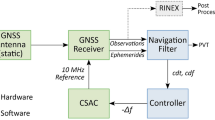Abstract
Due to the maximum of the solar cycle, ionospheric activity increased considerably last year. At frequent times warning were sent out announcing geomagnetic storms disturbing the ionospheric electron content. In this article the influence of such geomagnetic storms on fast and precise GPS positioning (for surveying applications at midlatitude regions) is studied. And here with “fast” it is aimed at the shortest observation time possible: carrier ambiguity resolution and position estimation using only one single epoch of data. To apply this instantaneous data processing technique successfully to GPS baselines of medium length (up to 50 km), additional ionospheric information is inevitable, not only under geomagnetic storm but also under more quiet conditions. However, in this article it will be shown that under geomagnetic storm conditions, even for rather short baselines (<10 km), for which the ionospheric delays under more quiet conditions could be neglected, one has to account for significant relative ionospheric delays. Therefore an important facet of this contribution is the investigation of how to process baselines of varying length in a more uniform way, making use of a permanent GPS network (if available in the surveying area) and a stochastic modeling technique of the ionospheric delays. © 2001 John Wiley & Sons, Inc.
Similar content being viewed by others
Author information
Authors and Affiliations
Rights and permissions
About this article
Cite this article
Odijk, D. Instantaneous Precise GPS Positioning under Geomagnetic Storm Conditions. GPS Solutions 5, 29–42 (2001). https://doi.org/10.1007/PL00012884
Published:
Issue Date:
DOI: https://doi.org/10.1007/PL00012884




